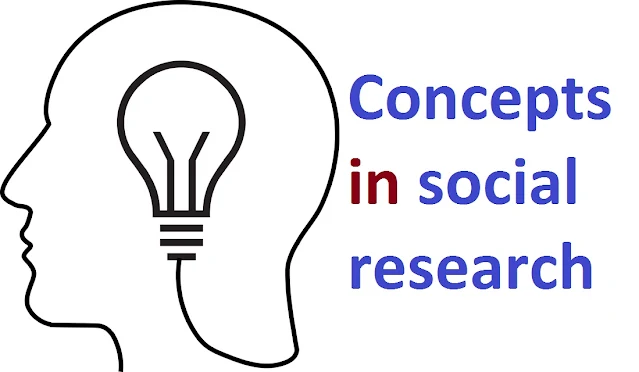Meaning of Concepts:
Social scientists conduct research on two distinct but interrelated levels: conceptual-theoretical and observational-empirical. More precisely, social researches involve a constant interplay of two process-theory construction and theory testing. For example, it is a fact that in the last 100 years social mobility has increased. This fact is not merely based on random observation but is an empirically verified statement about phenomena. This involves both scientific observation and a predetermined conceptual-theoretical framework by which the observation is guided. In this article, the conceptual theoretical level of social research has been explained with the help of basic elements such as concept.Dey (1993: 275) defines the term concept as "a general idea which stands for a class of objects." Concepts are "umbrella" terms. For example, the concept of class refers both to the classification of people according to income or employment, and to judgments that we might make about others (or of course ourselves). Examples of concepts include truth, beauty, evil, time, hunger, love, destiny, ethnicity, gender, class, and space. In quantitative research, it is very important to define the meanings of key concepts in advance in order to measure them systematically. This requires being clear about the indicators that we are going to use that will stand-in for the concept.
For example, if our research is concerned with poverty we might define poverty in terms of income or benefit groups, housing size, and so forth. For some qualitative researchers, generating conceptual categories at the analysis stage will be much more common, because such researchers are interested in the perceptions of their respondents. This does not, however, mean that if we are planning to conduct qualitative research we need to give no initial thought to defining concepts. We still need to be explicit and aware of how we are defining concepts in the research questions that we formulate, and in the observations and interviews, we conduct. The way we define concepts will shape the data we collect (Blaxter et al. 2002: 38).
To understand and communicate information about objects and events, there must be a common ground on which to do it. Concepts serve this purpose. A concept is a generally accepted collection of meanings or characteristics associated with certain events, objects, conditions, situations, and behaviors (Goode & Hatt, 1952: 41; Kumar, 1999; Das, 2000: 31). Concepts are mental images of perceptions and therefore their meaning varies markedly from individual to individual. Classifying and categorizing objects or events that have common characteristics beyond any single observation create concepts. When you think of a spreadsheet or a warranty card, what comes to mind is not a single instance but collected memories of all spreadsheets and warranty cards abstracted to a set of specific and definable characteristics (Cooper & Schindler, 2003: 41; Ghosh, 1999: 121; Kumar, 1999: 48; Young, 2000).
We use concepts all the time in everyday life. They are the abstract terms we employ to explain or make sense of our experience. Take a term such as happiness. We learn at a relatively early age that happiness means the state of being happy. We also learn to use this term in evaluating experiences and phenomena, which we perceive as making us happy (or unhappy). Thus, the term happiness represents a concept, or abstract idea, which we apply to a particular situation (Baker, 1999: 102).
We abstract such meanings from reality and use words as labels to designate them. For example, we see a man passing and identify that he is running, walking, skipping, crawling, or hopping. These movements all represent concepts. We also have abstracted certain visual elements by which we identify that the moving object is an adult male, rather than an adult female or a truck or a horse. We use large numbers of concepts daily in our thinking, conversing, and other activities. A concept expresses an abstraction formed by generalization from particulars. "Weight" is a concept: it expresses numerous observations of things that are more used or by less physical "heavy" scientists or "light." "mass," "energy," are concepts used by physical scientists.
Sources of Concepts
Concepts that are in frequent and general use have been developed over time through shared usage. We have acquired them through personal experience. If we lived in another society, we would hold many of the same concepts (though in a different language). Some concepts, however, are unique to a particular culture and are not readily translated into another language.Ordinary concepts make up the bulk of communication even in research, but we often run into difficulty trying to deal with an uncommon concept or a newly advanced idea. One way to handle this problem is to borrow from other languages (for example, gestalt) or to borrow from other fields (for example from art, impressionism). The concept of gravitation is borrowed from physics and used in marketing in an attempt to explain why people shop where they do. The concept of distance is used in attitude measurement to describe the degree of variability between the attitudes of two or more persons. The threshold is used effectively to describe a concept in perception studies; velocity is a term borrowed by the economist from the physicist (Pokharel, 2005: 20).
Borrowing is not always practical, so we sometimes need to adopt new meanings for words (make a word cover a different concept) or develop new labels (words) for concepts. The recent broadening of the meaning of the model is an example of the first instance; the developments of concepts such as sibling and status-stress are examples of the second. When we adopt new meanings or develop new labels, we begin to develop specialized jargon or terminology. Researchers in medicine, the physical sciences, and related fields frequently use terms that are unintelligible to outsiders. Jargon no doubt contributes to the efficiency of communication among specialists, but it excludes everyone else.
Types of Concepts
Concepts may be classified into concrete concepts and abstract concepts.1.Concrete concepts
Concrete concepts symbolize material objects, which can be seen, touched, and felt, e.g ., book, table, building. Concepts and facts are not exactly the same. The concept symbolizes the empirical relationships and phenomena which are stated by facts. Fact is thus, a logical construct of concepts. In other words, concepts are basic to the scientific method as well as the foundation of all human communication and thought. For example, water, mass, weight, and density are used by physical scientists. There are many similar terms such as a tree, temple, chalk, and so on for which we can point out numerous objects and measure their dimensions.
2. Abstract concepts
Abstract concepts refer to properties or characteristics of objects, e. g ., weight, height, attitude, intelligence, and leadership. Concepts are abstract or general ideas, which are important to how we think about particular subjects or issues (Blaxter et al. 2002: 205). They are constructs i.e., they represent inference deduced from observable events. They symbolize inference at a higher level of abstraction from concrete events and their meaning cannot be easily conveyed pointing to specific objects, individuals, or events (Selltiz et al., 1976; Krishnaswami & Ranganathanm, 2005: 92). Concepts are abstractions and represent only certain aspects of reality (Martin, 2004: 24; Young, 2000).
Problems in the use of Concept:
The use of concepts presents difficulties that are accentuated in a research setting. First, people differ in the meanings they include under any particular table. This problem is so great in normal human communication that we often see cases where people use the same language but do not understand each other. We might all agree to the meaning of such concepts as a dog, table, electric light, money, employee, and wife. We may encounter more difficulties, however, when we communicate concepts such as household, retail transaction, dwelling unit, regular user, debit, and wash sale.Still, more challenging is concepts that are familiar but not well understood, such as leadership, motivation, personality, social class, and fiscal policy. For example' personality has been defined in the research literature in more than 400 ways (Hoover, 1991: 21). Although this may seem extreme, writers are not able to express the complexity of the determinants of personality and its attributes (e.g., authoritarianism, risk-taking, locus of control' achievement orientation, and dogmatism) in a fashion that produces agreement (Saunders et al. 2003).
The concepts described represent progressive levels of abstraction-that is, the degree to which the concept does or does not have an objective Table is an objective concept in that we can point to tables and we can conjure up in our mind images of tables. An abstraction-like personality is much more difficult to visualize. Such abstract concepts are often called constructs.






![Nepal Army New Salary Scale 2081 Shrawan 1 [Updated info]](https://blogger.googleusercontent.com/img/b/R29vZ2xl/AVvXsEiLtlRnBeO0VnCyvGBTUFOxN28WvPPTRbMbGvdfac-claanxRt34mwhwJKv0amOrBhOQT2e_jsvLK4ZwV6Ix0V3X8VWpXkSo2DO8O6BiMiVG7P4C9mEej-1mozufPkjPueqNwdWQ9mKRTQ5UWeKf_h7qltPvz-7DyxDkpyOUJGMJ1zM9C61fDndYu_cTsVq/w680/new-salary-scale-in-nepal-2080-81-shrawan-1.jpg)
![New Salary Scale in Nepal 2081/82 Shrawan 1 [Updated Info]](https://blogger.googleusercontent.com/img/b/R29vZ2xl/AVvXsEh2mfAXxpAmWIugqeA78OUgdlqdPBxzOmvX-miVljRXsThVRNvSJvfB-3UEvA2VR-RtYxZL3OD2AiNIEuFyy3tuPZsMvicfZUWkvH9suE0G-2zkD5C1Da-Wav2If-kfrgNuHPjQB-XGJ9rMox5c-csbdDuOECenNvc48NUKsVk0_ICti_Z-WuWlKze0qcnk/w680/new-salary-scale-in-nepal-2080-81-shrawan-1.jpg)

If this article has helped you, please leave a comment.